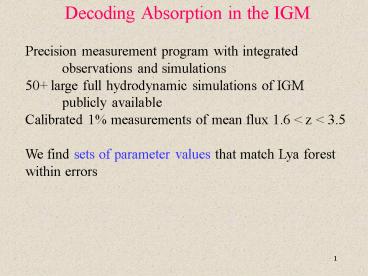Decoding Absorption in the IGM - PowerPoint PPT Presentation
1 / 24
Title:
Decoding Absorption in the IGM
Description:
Spectra 77 QSOs z=2 from Lick Kast spectrograph. Measured mean absorption from Ly-alpha in IGM. ... Lick 250 km/s. 24 QSOs HIRES 8 km/s. Removed mean metal ... – PowerPoint PPT presentation
Number of Views:75
Avg rating:3.0/5.0
Title: Decoding Absorption in the IGM
1
Decoding Absorption in the IGM
Precision measurement program with integrated
observations and simulations 50 large full
hydrodynamic simulations of IGM publicly
available Calibrated 1 measurements of mean flux
1.6 that match Lya forest within errors
2
Publications
David Tytler, David Kirkman, John M. O'Meara, Nao
Suzuki, Adam Orin, Dan Lubin, Pascal Paschos,
Tridivesh Jena, Wen-Ching Lin, Michael L. Norman
University of California, San Diego
Avery Meiksin University of Edinburgh Tytler
et al 2004 ApJ 617, 1 astro-ph/0403688 Tytler et
al 2004 AJ 128, 1058 astro-ph/0405051 Kirkman et
al 2005 MNRAS in press 0504391 Jena et al 2005
MNRAS in press 0412557
3
H absorption is sensitive to many Parameters
cosmological parameters Ho, O? Om Ob, Pk (n,
s8) astrophysical parameters UVB
photoionization heating (UVB
spectrum) We need to adjust all of these to fit
the Lya Forest. If we know all but one, can find
that one, if priors well known potentially
small error, competitive with best current
4
Mean Flux 1 Lick Kast Spectra 77 QSOs
First calibrated measurement. Fit continua to
realistic artificial spectra with known mean
flux. Prior measurements were significantly less
accurate -the main error in measurement of the
matter power spectrum.
5
Mean Flux 2 We use HIRES at z 2.2 3.5
Sigma of continuum fit error per 121Ang is 1.2.
Mean error for 275 such segments is 0.29
HIRES flux calibrated with 2 fits One of 4
artificial, realistic emission lines and errors
1070-1170 rest
6
Emission lines everywhere
Suzuki ApJ in press astro-ph/0503248
7
Emission Lines Sometimes Strong
In low S/N they are hard to see. You might place
continuum too low and systematically
underestimate the amount of absorption
8
Measured Mean Ly-alpha Absorption
Spectra 77 QSOs z2 from Lick Kast
spectrograph Measured mean absorption from
Ly-alpha in IGM. First calibrated measurement
Tytler et al ApJ 617, 1, 2004
9
IGM only Absorption
Removed mean metal lines and Lya from LLS from
each point
24 QSOs HIRES 8 km/s
77 QSOs Lick 250 km/s
10
Detected LSS at 153 Mpc at z1.9
Large Scale Structure makes 1/3 of the
dispersion in mean absorption in 121 Angstrom
segments sigma(DA) 3.5
Simulation, 76.8 Mpc box. Kast spectra,
including metals and Lya of LLS
11
Absorption due to LyaF alone
DA Absorption Fraction of flux absorbed in
Lya Forest, no metals, no Lya of LLS
Fbar(z2)0.873 Fbar(z3)0.719
0.0062(1z)2.75
If DA(z) is smooth function, we have 1 error,
mostly from metal subtraction
12
Mean Absorption
blank
Our new measurement give less absorption than
prior work, and not just from the metal and LLS
removal. This requires more ionizing photons
13
50 large Hydrodynamic Simulations
Cell size 18, 37, 75, 150 kpc (comoving,
h0.71) Box size 9, 19, 38, 77 Mpc
(comoving) various s8, UVB intensity, heating
from He II ionizations Available on web
astro-ph/0412557 Jena et al., or email
log baryon density, z2, from 1024 cube, 75 kpc
cells
14
Controlling the Temperature
We control temperature using X228 heat per HeII
ionization, in HM III units The rate of HI and
HeII ionization depends on intensity The heating
per baryon depends on X228 We hope that X228 1
corrects for opacity missing because our
simulations are optically thin. We find X228
1, the heating from the HM III spectrum shape,
matches data.
15
Line Width constrains IGM Temperature
Less heating, cooler gas more narrow lines
Line per unit z per km/s
Line width b (km/s)
16
Mean line Width constrains IGM Temperature
Simulation with T14,300 K at mean density at z2
s80.9,
n1 fits Kim et al 286 lines
Line per km/s
log NHI 12.5 14.5
Ly-alpha Line width b (km/s)
17
Temperature-Density
14,300 K at mean density at z2
18
Homogeneous Reionization Simulation LCDMHMIII
Paschos Norman (2004)
19
The UVB to Fit Lya Forest depends on s8
HI, HeII photoionization rate (Haardt Madau III
1)
Heating due to He II ionization (Haardt Madau
III 1)
Hotter
move UV photons
s8 (n1)
s8 (n1)
20
Mean UVB Intensity
We obtain sets of parameters h0.71, O?
0.73, Om 0.27, Ob 0.044, n1.0, s8
0.90 that agree with Lya forest data at z2
line widths, mean flux, power spectrum when rate
of photoionization of H by UVB is Gamma 1.33
x 10-12 per HI atom per second or J0.30 x
10-21 erg/cm2/s/Hz/sr. Error 30 (Bolton et
al.) very close to HM III However, at z3, we
still need Gamma 1.3 x 10-12 per HI atom per
second about 1.3 times the HM III rate missing
photons?
21
Three Baryon Density Measurement Agree
Baryon density measured in 3 independent ways
IGM result requires priors for all main
cosmological and astrophysical parameters. The
error quoted is from 1 error in mean flux alone.
External error much larger If equivalence of
values holds up SBBN applies no extra
relativistic particles constancy of the baryon
and photon densities no missing baryons at z2
22
Higher Accuracy Temperature
To get more accurate temperature distribution we
need radiative transfer of photons from the
individual QSOs that we suspect reionized the
HeII. We need huge simulations because they are
rare. Paschos, Norman Bordner used a 100 Mpc
simulation that was optically thin in HI and HeI
ionizing photons. They post-processed to include
RT of HeII ionizing photonsbut do not resolve
LyaF. Adding RT to AMR
23
Late He II Reionization by QSOs
Will be able to match HeII opacity follow
temperature evolution of IGM
Z5
Z3
Z2.6
Z6
Z3.2
Paschos, Norman Bordner (2005)
Z2.6
24
blank
blank































